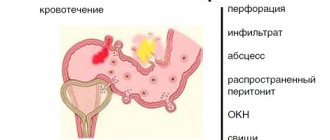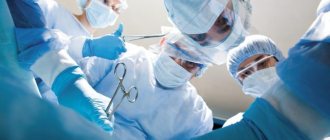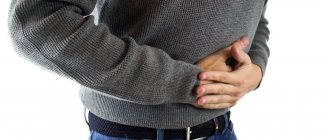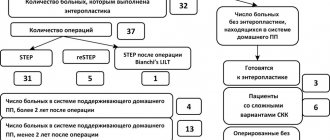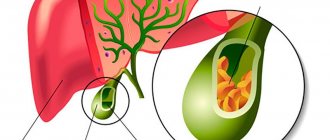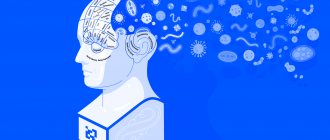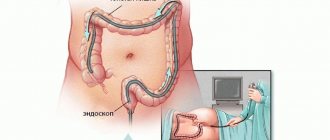Gastroenterologist
Belousov
Evgeniy Leonidovich
20 years of experience
Candidate of Medical Sciences, Member of the Russian Gastroenterological Association.
Make an appointment
Intestinal diverticulitis is inflammation of the diverticula. This is the name given to blindly ending protrusions of the intestinal wall. Inflammation forms against the background of stagnation of intestinal contents. Most often, this problem occurs in women - one and a half times more often than in males. The risk of encountering this disease increases with age - usually starting at age 40 and older.
Generally speaking, this disease has become more common in recent years, which is usually associated with poor diet and the fact that people pay little attention to their own health.
Symptoms and signs
Diverticulitis is characterized by many symptoms, but the problem is that very often they are similar to the symptoms of other diseases: for example, problems with the kidneys or female genital organs. But a person should still be alert to the following signs of the disease:
- pain in the lower abdomen. Usually it is point-like, it bothers only in a specific place - and it can hurt for several days, then fading, then starting again. The sensation intensifies with sudden muscle contractions: during laughter, coughing, physical activity;
- increased pain after bowel movements, during pressure;
- bowel disorders - intestinal diverticulitis manifests itself as both constipation and diarrhea;
- the presence of blood in the stool - usually the bleeding is not very abundant and is observed only in a tenth of patients;
- fever, chills. When it comes to diverticulitis, symptoms of this nature are rare, but they are also possible;
- loss of appetite - the patient does not feel like eating;
- nausea, vomiting, general weakness of the body - these signs of diverticulitis are very similar to the symptoms of poisoning.
If a patient has intestinal diverticulitis, the symptoms, although misleading, are still quite pronounced and bright, and therefore require immediate consultation with a doctor for a thorough examination.
Another important clarification about diverticulitis: the symptoms in women and men will be similar, although in the latter this disease is less common. In this case, we are talking only about the prevalence of the disease, but not about the fact that it manifests itself in different ways. The only peculiarity is that women can confuse this disease with “female-style” ailments, but there are nuances here, because there will still be some signs similar to poisoning.
Are you experiencing symptoms of diverticulitis?
Only a doctor can accurately diagnose the disease. Don't delay your consultation - call
Incidence of diverticular disease
Of all the diseases of the colon, intestinal diverticula are one of the most common in the modern world. The incidence of diverticular disease averages 20% in European countries; moreover, in older age groups of the population (60–80 years), the incidence increases, reaching 40–50%, and among patients over 80 years of age, the incidence reaches 60–65%. In our country, diverticula of the large intestine are found in approximately 17-28% of gastroenterological patients. The incidence of the disease in men and women is approximately the same.
Reasons for development
Diverticulitis of the sigmoid colon and other parts of the intestine is caused by a number of reasons:
- eating foods that don't have enough fiber. For proper intestinal function, a person needs to consume a sufficient amount of dietary fiber;
- complication due to infectious colitis, intestinal infections - the risk of a problem occurring against the background of weakened immunity is especially high;
- decreased muscle tone and deterioration of peristalsis - as a rule, this happens against the background of age-related changes, then colon diverticulitis manifests itself;
- dysbacteriosis, which also entails a general decrease in immunity;
- infection with worms, as a result of which the intestinal microflora is disrupted, the mucous membrane is damaged - and because of this, diverticulitis of the sigmoid colon begins;
- heredity is also one of the significant factors.
Some of the factors that cause intestinal diverticulitis are something that can be avoided if you lead a healthy lifestyle and monitor your condition, regularly visiting doctors for prevention and timely treatment.
What is intestinal diverticulum?
Diverticula are pouch-shaped protrusions of the intestinal wall that form in “weak” areas of the intestinal wall. There are true diverticula, which have all layers of the intestinal wall in their structure, and false ones, in which there is no muscle layer.
The diverticulum is divided into the mouth, the neck, the body and the bottom of the diverticulum. The blood supply to the diverticulum is carried out from the vessels of the submucosal layer from which thin vascular branches extend, piercing the intestinal wall and heading to the bottom of the diverticulum.
When a diverticulum forms in the projection of the fatty suspension and mesentery of the colon, it is covered on the outside with adipose tissue; when a diverticulum forms in the free edge of the intestinal wall, it is covered on the outside only with a serous membrane.
Based on the number, a single diverticulum and multiple diverticula of the colon are distinguished.
Based on the location of diverticula, right-sided, left-sided and total damage to the colon is distinguished.
Diverticulosis of right-sided localization, as a rule, is congenital in nature with a predominance of true diverticula.
With left-sided localization, diverticulosis is in most cases acquired and there is no muscle layer in the structure of diverticula.
Risk factors
Before you learn how to treat diverticulitis, it is worth addressing the risk factors. In this case, these include the already mentioned heredity, age, as well as poor nutrition and lifestyle, which contribute to impaired peristalsis. For example, people who sit a lot, hardly move, and have weak muscles are at risk. Many people hardly associate sports and peristalsis, but developed abdominal muscles really help the intestines to function properly. But you can’t get too carried away with heavy sports - otherwise there will be a backlash.
We also include anyone who does not follow the drinking regime into the risk zone - without a sufficient amount of moisture, the contents of the intestine become too dense, which can cause damage to its walls. Those who abuse bad habits, do not follow basic hygiene rules and do not take good care of their health are also in danger.
Forecast
The prognosis is usually favorable if the disease is detected in a timely manner and the necessary preventive and therapeutic measures are started, provided that the patient follows all the necessary recommendations. However, if the need for prevention is ignored, diverticular disease can lead to the development of severe complications that threaten the life and health of the patient. Moreover, the disease is more common among older people who have a variety of concomitant diseases and lower body resistance.
Diagnosis of diverticulitis
To diagnose diverticulitis, symptoms are not the only thing the doctor will rely on. This will require a whole range of research:
- consultation with both a gastroenterologist and a proctologist. Palpation, examination, history taking;
- colonoscopy;
- radiography with contrast;
- Ultrasound of the abdominal organs;
- laparoscopy (in some cases);
- blood biochemistry (will show inflammatory processes in the body).
It is important to understand that many tests, even if they cause distress for the patient, are very important to identify diverticulitis, the treatment of which should be different from other problems. The same colonoscopy is one of the most effective tools that allows you to distinguish between inflammation of diverticula and ulcerative colitis, intestinal obstruction, and colon tumor. And the more accurate the diagnosis, the higher the chance that the doctor will select a high-quality, working treatment.
In our clinic in the center of Moscow, diagnostics are carried out at the highest level - only using modern, most effective and safe equipment. Thanks to this, if intestinal diverticulitis is diagnosed, the treatment will also be of high quality.
X-ray contrast examination of the intestines
Irrigoscopy or X-ray contrast examination of the intestine allows you to take an X-ray and see the outline of the large intestine. It is carried out in equipped diagnostic rooms. In order to see the outlines of the internal organs, the patient is injected with a contrast liquid. We are talking about a solution of barium sulfate. As a rule, the contrast agent is administered through an enema or by ingestion.
The endoscopist takes pictures in a lying and standing position to observe the functioning of the internal organs in different situations.
Treatment
When a diagnosis of diverticulitis is made, treatment is prescribed individually, depending on the patient’s condition. In some cases, treatment in a medical facility is required; if the situation is not so advanced, you can be treated at home, periodically visiting the clinic.
Diverticulitis is treated in the following ways:
- drug therapy. This usually involves taking antibiotics;
- a strict diet for diverticulitis with a sufficient amount of fiber, without harmful foods;
- surgical intervention (in very complex, serious cases during exacerbation or complications).
The outcome of the disease will largely depend on the patient: on his timely visit to the doctor, compliance with all recommendations and, of course, the right lifestyle.
Classification of diverticular disease
- Uncomplicated.
This form is detected accidentally during an X-ray or endoscopic examination of the intestine. Blood tests usually show no changes. The examination must be carried out to assess the extent of intestinal damage, prognosis of the course of the disease and the choice of a method for preventing complications or treatment. - Complicated
, occurring with an acute inflammatory process (diverticulitis, diverticular infiltrate, diverticulum perforation, abscess, peritonitis), a chronic inflammatory process, as well as bleeding. A chronic process includes situations when inflammation cannot be eliminated within 6 weeks, or it occurs again. In severe cases, an infiltrate, narrowing of the intestine, or a fistula from a destroyed diverticulum may form.
Prevention
Preventive measures for the formation of diverticulitis look like this:
- a healthy lifestyle with proper nutrition, drinking regimen and sufficient exercise;
- maintaining the immune system in good condition - for example, taking the necessary vitamins during the cold season;
- timely solution to any problems related to the intestines, be it diarrhea or constipation.
Diverticulitis, the symptoms and treatment of which are already clear to you, is not for nothing called an age-related problem. Very often it arises against the backdrop of a combination of factors that a person has ignored for a very long time and did not take into account. If you take good care of your health, you can significantly reduce the risk of such a problem.
Diet
Since diverticular disease occurs much more often in people who limit their intake of vegetables and fruits, all patients with diverticulosis need to use foods high in plant fiber and pectin. Wheat bran (especially coarse bran) is very useful, which significantly reduces the pressure inside the intestine and accelerates the rate of movement of contents through the intestines.
It is imperative to exclude all foods that cause increased gas formation (legumes, lentils, grapes, sauerkraut, butter and yeast dough, onions) and constipation (blueberries, rice). It is also advisable to exclude seeds, fruits with a large number of grains and excessively coarse fiber (persimmons, pineapples, turnips, radishes, radishes).
How to make an appointment with a gastroenterologist
You can make an appointment with a gastroenterologist at Meditsina JSC (academician Roitberg’s clinic) on the website - the interactive form allows you to select a doctor by specialization or search for an employee of any department by name and surname. Each doctor’s schedule contains information about visiting days and hours available for patient visits.
Clinic administrators are ready to accept requests for an appointment or call a doctor at home by calling +7 (495) 775-73-60.
Convenient location on the territory of the central administrative district of Moscow (CAO) - 2nd Tverskoy-Yamskaya lane, building 10 - allows you to quickly reach the clinic from the Mayakovskaya, Novoslobodskaya, Tverskaya, Chekhovskaya and Belorusskaya metro stations .
How dangerous is diverticulosis?
Since the intestines suffer greatly with diverticulosis, this threatens the development of complications such as:
- Peritonitis.
- Abscess.
- Perforation of the intestinal wall.
- Phlegmon of the retroperitoneum.
- Internal bleeding.
- Fistula formation.
- Intestinal obstruction.
Diverticulosis increases the risk of developing a malignant tumor in the intestine.
